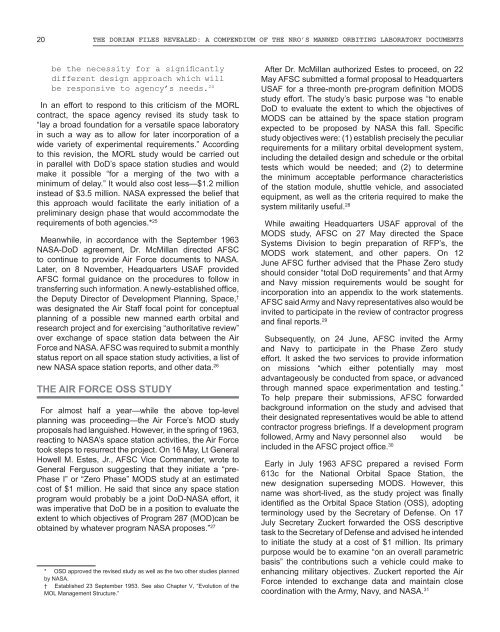NRO-MOL_2015
Create successful ePaper yourself
Turn your PDF publications into a flip-book with our unique Google optimized e-Paper software.
20 The Dorian Files Revealed: a Compendium of the <strong>NRO</strong>’s Manned Orbiting Laboratory Documents<br />
be the necessity for a significantly<br />
different design approach which will<br />
be responsive to agency’s needs. 24<br />
In an effort to respond to this criticism of the MORL<br />
contract, the space agency revised its study task to<br />
“lay a broad foundation for a versatile space laboratory<br />
in such a way as to allow for later incorporation of a<br />
wide variety of experimental requirements.” According<br />
to this revision, the MORL study would be carried out<br />
in parallel with DoD’s space station studies and would<br />
make it possible “for a merging of the two with a<br />
minimum of delay.” It would also cost less—$1.2 million<br />
instead of $3.5 million. NASA expressed the belief that<br />
this approach would facilitate the early initiation of a<br />
preliminary design phase that would accommodate the<br />
requirements of both agencies.* 25<br />
Meanwhile, in accordance with the September 1963<br />
NASA-DoD agreement, Dr. McMillan directed AFSC<br />
to continue to provide Air Force documents to NASA.<br />
Later, on 8 November, Headquarters USAF provided<br />
AFSC formal guidance on the procedures to follow in<br />
transferring such information. A newly-established office,<br />
the Deputy Director of Development Planning, Space, †<br />
was designated the Air Staff focal point for conceptual<br />
planning of a possible new manned earth orbital and<br />
research project and for exercising “authoritative review”<br />
over exchange of space station data between the Air<br />
Force and NASA. AFSC was required to submit a monthly<br />
status report on all space station study activities, a list of<br />
new NASA space station reports, and other data. 26<br />
The Air Force OSS Study<br />
For almost half a year—while the above top-level<br />
planning was proceeding—the Air Force’s MOD study<br />
proposals had languished. However, in the spring of 1963,<br />
reacting to NASA’s space station activities, the Air Force<br />
took steps to resurrect the project. On 16 May, Lt General<br />
Howell M. Estes, Jr., AFSC Vice Commander, wrote to<br />
General Ferguson suggesting that they initiate a “pre-<br />
Phase I” or “Zero Phase” MODS study at an estimated<br />
cost of $1 million. He said that since any space station<br />
program would probably be a joint DoD-NASA effort, it<br />
was imperative that DoD be in a position to evaluate the<br />
extent to which objectives of Program 287 (MOD)can be<br />
obtained by whatever program NASA proposes.” 27<br />
* OSD approved the revised study as well as the two other studies planned<br />
by NASA.<br />
† Established 23 September 1953. See also Chapter V, “Evolution of the<br />
<strong>MOL</strong> Management Structure.”<br />
After Dr. McMillan authorized Estes to proceed, on 22<br />
May AFSC submitted a formal proposal to Headquarters<br />
USAF for a three-month pre-program definition MODS<br />
study effort. The study’s basic purpose was “to enable<br />
DoD to evaluate the extent to which the objectives of<br />
MODS can be attained by the space station program<br />
expected to be proposed by NASA this fall. Specific<br />
study objectives were: (1) establish precisely the peculiar<br />
requirements for a military orbital development system,<br />
including the detailed design and schedule or the orbital<br />
tests which would be needed; and (2) to determine<br />
the minimum acceptable performance characteristics<br />
of the station module, shuttle vehicle, and associated<br />
equipment, as well as the criteria required to make the<br />
system militarily useful. 28<br />
While awaiting Headquarters USAF approval of the<br />
MODS study, AFSC on 27 May directed the Space<br />
Systems Division to begin preparation of RFP’s, the<br />
MODS work statement, and other papers. On 12<br />
June AFSC further advised that the Phase Zero study<br />
should consider “total DoD requirements” and that Army<br />
and Navy mission requirements would be sought for<br />
incorporation into an appendix to the work statements.<br />
AFSC said Army and Navy representatives also would be<br />
invited to participate in the review of contractor progress<br />
and final reports. 29<br />
Subsequently, on 24 June, AFSC invited the Army<br />
and Navy to participate in the Phase Zero study<br />
effort. It asked the two services to provide information<br />
on missions “which either potentially may most<br />
advantageously be conducted from space, or advanced<br />
through manned space experimentation and testing.”<br />
To help prepare their submissions, AFSC forwarded<br />
background information on the study and advised that<br />
their designated representatives would be able to attend<br />
contractor progress briefings. If a development program<br />
followed, Army and Navy personnel also would be<br />
included in the AFSC project office. 30<br />
Early in July 1963 AFSC prepared a revised Form<br />
613c for the National Orbital Space Station, the<br />
new designation superseding MODS. However, this<br />
name was short-lived, as the study project was finally<br />
identified as the Orbital Space Station (OSS), adopting<br />
terminology used by the Secretary of Defense. On 17<br />
July Secretary Zuckert forwarded the OSS descriptive<br />
task to the Secretary of Defense and advised he intended<br />
to initiate the study at a cost of $1 million. Its primary<br />
purpose would be to examine “on an overall parametric<br />
basis” the contributions such a vehicle could make to<br />
enhancing military objectives. Zuckert reported the Air<br />
Force intended to exchange data and maintain close<br />
coordination with the Army, Navy, and NASA. 31

















